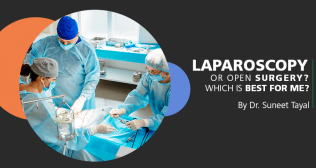
Obstetrics and Gynaecology
Fibroids In The Uterus - Need Your Attention!
Fibroids In The Uterus - Need Your Attention! Aug 23, 2019

Fibroids are benign (non-cancerous) tumors of the womb (uterus). They are common and usually harmless. Almost every third or fourth woman will have fibroids. However, women need to be aware that they may have fibroids and they should not panic about these fibroids. Fibroids have therefore earned themselves the name of "womb stones" because they are not dangerous in any way, mostly.
Some fibroids, however, in some women, can be troublesome. They can result in heavy menstrual periods, frequent periods, leg pains and backache, frequent urination, headaches, constipation, difficulty in emptying the bladder, almost continuous vaginal spotting or discharge with ongoing anemia and weakness. At times, they can cause abdominal pain or cramps. Rarely, they can also result in inability to conceive, cause pressure effects on the urinary bladder and nearby organs, or even result in premature labor or miscarriage.
The actual cause of uterine fibroids is still unknown, however, as per some research studies, some of the suspected causes for fibroids include genetic changes in the body, hormonal changes (fibroids tend to contain increased amounts of progesterone and estrogen receptors than normal muscle cells in the uterus), other growth factors (insulin-like growth factor tends to affect the growth of the uterine fibroids), and ECM (extracellular matrix), which makes the fibroids more fibrous.
Ultrasonography or MRI confirms the diagnosis of the Fibroids. If the fibroids are sitting quietly in the uterus, not making any trouble, then these need to be monitored for growth through a regular annual pelvic ultrasound. However, if these are causing symptoms and ill health, Fibroids need to be weeded out. The removal of fibroids is known as "Myomectomy". Currently, laparoscopic (keyhole surgery) or hysteroscopic (endoscopic surgery via the vagina) are the modalities of choice for removing fibroids.
Unusually, open surgery may be required if the fibroids are excessively large, multiple in number, inconveniently located or if inadequate expertise is available to remove these endoscopically by minimal access techniques. In case, the woman does not wish further childbearing, the uterus may be removed completely, which in turn removes the chance of any reoccurrence. Once the fibroids have been removed, (histopathology) biopsy should be performed to confirm the treatment. In extremely rare cases, i.e. 1 in 350 to 1 in 1000 women, the fibroids can be malignant (sarcomatous).
Non- surgical options are also available in the form of oral medications or the use of an intrauterine device Mirena, to manage symptoms. Uterine artery embolization and HIFU are techniques available to shrink the fibroids but these techniques have their own disadvantages.
All women with the abovementioned symptoms should get themselves checked and treated. Treatment should be individualized and tailored to each woman, after discussion and mutual agreement, as every woman would respond to and require a customized treatment based on her circumstances and present state. So, if you have fibroids, give them the attention they deserve and do yourself a favor.



















